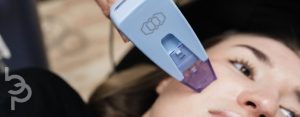A few years ago, no one had even heard of microneedling, but now it has become quite popular as a minimally invasive cosmetic procedure.
It’s also well known for its ability to rejuvenate the skin and address various skin concerns. While microneedling is praised for its effectiveness, many individuals considering the treatment often wonder about the level of discomfort involved.
In this article, we explore the question: Does microneedling hurt or is microneedling painful? We’ll delve into what is microneedling, potential pain management strategies, and the overall experience of undergoing this treatment.
What Is Microneedling Good For?
Microneedling, also known as collagen induction therapy, involves the use of a device with fine needles that create controlled micro-injuries in the skin.
These micro-injuries stimulate the body’s natural healing processes, leading to the production of collagen and elastin – the building blocks of healthy, youthful skin. The procedure is known for its versatility in addressing concerns such as fine lines, wrinkles, acne scars, enlarged pores, and uneven skin texture.
Pain Perception
The sensation experienced during microneedling can vary from person to person. It’s influenced by factors such as:
- Individual pain tolerance
- The specific area being treated
- The depth of the needles used
Generally, patients describe the sensation as mild discomfort rather than intense pain. The procedure is typically well-tolerated, and many individuals find the benefits outweigh any temporary discomfort.
You can think of waxing as a similar example. Some folks find the experience of waxing easy and painless, soothing even. But others can’t stand it and are running in the opposite direction after one experience.
The same applies to microneedling. You won’t know how painful it will be for you until you try it. You might be surprised at how painless it is and confused by all the fuss others make about it.
Factors Influencing Pain Perception
Everyone is unique in their pain perception. That’s what makes living in this world so interesting. Here are some factors that can negatively or positively influence pain perception.
Needle Depth
The depth at which the needles penetrate the skin can influence the level of discomfort. Deeper microneedling treatments, such as those targeting scars or deeper wrinkles, may cause slightly more discomfort than shallower treatments aimed at improving overall skin texture.
Topical Anesthetics
To enhance patient comfort, practitioners often apply a topical anesthetic to the treatment area before microneedling. This numbing cream helps minimize any potential pain during the procedure.
The effectiveness of the anesthetic can vary. Patients are encouraged to communicate with their providers about their comfort level.
Skin Sensitivity
Individuals with more sensitive skin may experience slightly heightened discomfort during microneedling. However, practitioners are trained to adjust the treatment parameters based on the patient’s skin type and sensitivity to ensure a positive experience.
Personal Pain Tolerance
Each person’s pain threshold is unique. What one individual perceives as mild discomfort, another may find more noticeable. It’s important for individuals considering microneedling to be aware of their own pain tolerance and communicate openly with their skincare professional.
What to Expect During Microneedling
Sometimes, knowing what to expect in a cosmetic procedure can reduce your fear of it. That’s why we have included this section here to give you a bit more information about microneedling itself.
Topical Anesthetic Application
Before the microneedling procedure begins, the skincare professional applies a topical anesthetic to the treatment area. This typically takes about 20-30 minutes to take effect. The anesthetic helps numb the skin, minimizing any discomfort during the procedure.
Needle Penetration Sensation
Once the topical anesthetic has taken effect, the microneedling device is carefully and systematically applied to the skin. Patients may feel a sensation of pressure or mild prickling as the needles penetrate the skin. The feeling is often described as similar to sandpaper gently gliding over the skin.
Overall Discomfort Level
Most individuals report mild discomfort during microneedling. It’s essential to communicate with the skincare professional throughout the procedure. If at any point the discomfort becomes more than expected, the professional can make adjustments or take steps to ensure the patient’s comfort.
Microneedling Aftercare
After microneedling, patients may experience temporary redness, swelling, or a mild sunburn-like sensation. These post-treatment effects are part of the skin’s natural healing process. They typically subside within a day or two.
Skincare professionals often provide post-care instructions and may recommend soothing products to minimize any discomfort. Make sure to follow all post-care instructions to a T, not skipping a single one. This will ensure even better results for your microneedling session.
Pain Management Strategies
If you are truly concerned about the pain and wish to do something to assuage it, there are certain pain management strategies to consider. Just like you would take ibuprofen before a waxing session to dull the pain, there are options for microneedling as well.
Topical Anesthetics
The application of a high-quality topical anesthetic is a standard practice before microneedling. This helps ensure patient comfort during the procedure.
Ice or Cold Compress
Some individuals find relief by applying an ice pack or cold compress to the treated area before microneedling. This can help numb the skin and reduce sensation.
Over-the-Counter Pain Medication
Taking an over-the-counter pain reliever, such as ibuprofen, before the procedure may help minimize discomfort. However, it’s crucial to consult with the skincare professional before using any medications.
Communication with the Provider
Open communication with the skincare professional is key. Informing them about any concerns, preferences, or past experiences with pain during cosmetic procedures allows them to tailor the microneedling experience to meet individual needs.
Does Microneedling Hurt? – It Depends
It’s common knowledge that pain perception isn’t a one-size-fits-all thing. Everyone deals with pain differently.
That’s why it’s hard to answer the question, “Does microneedling hurt?” But now you know some things that affect it. Ready to try it for yourself?
Beauti Pharm is the premium med spa serving the folks of Grand Blanc and surrounding Michigan areas. We use the latest medical aesthetic treatments on the market to give fantastic results.
Book an appointment with our team today for microneedling or any other cosmetic procedures you might be interested in.




